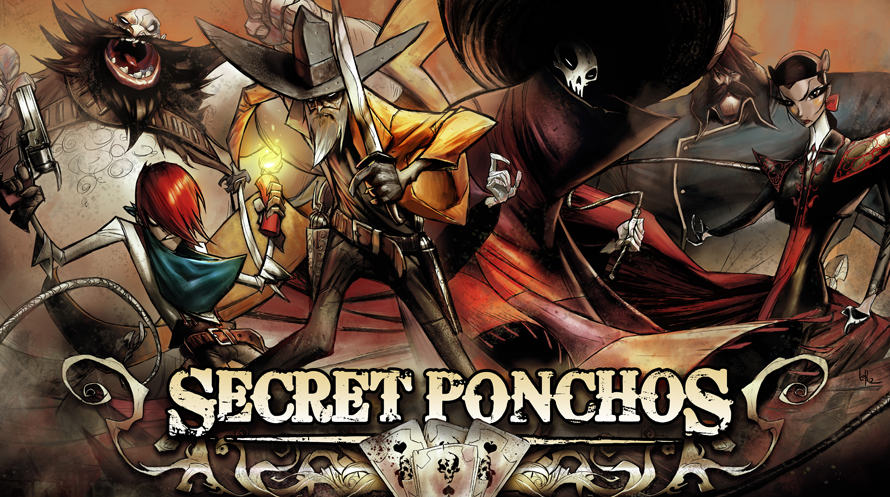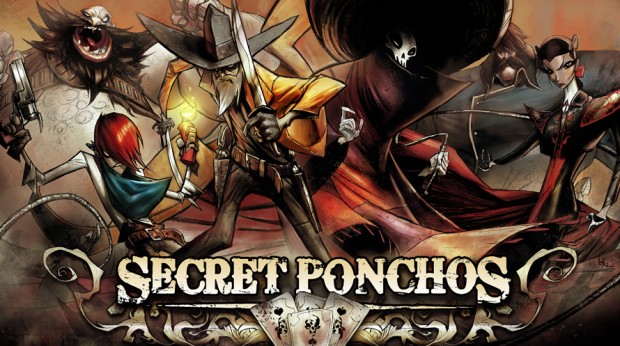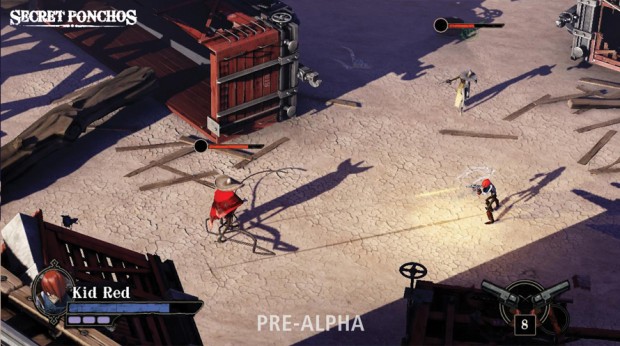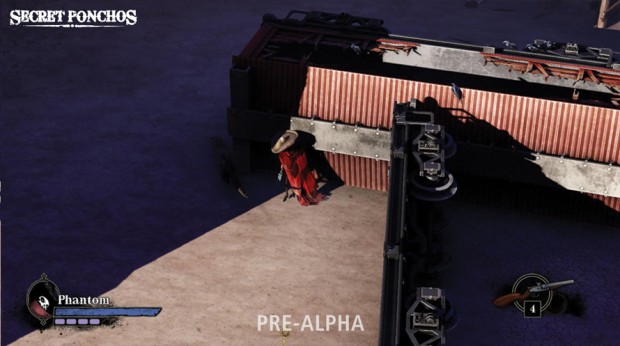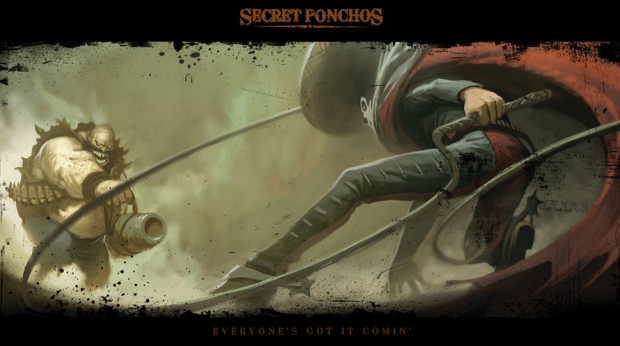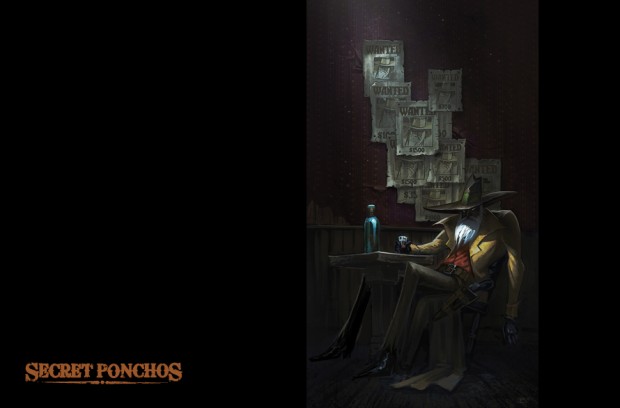Secret Ponchos and the virtual Wild West
Generations after the release of Sergio Leone’s classic western movies, two game developers from different companies sat back to listen to the iconic music. As the trumpets sang of the modern gladiators pining for infamy, these gamers looked at each other and instinctively thought, “We have to make a fighting game out of this.”
This is more or less what Yousuf Mapara told us back at PAX East where his studio, Switchblade Monkeys, showed off Secret Ponchos, a game has grown from a clubhouse hobby project to a unique take on competitive multiplayer.
After a brief look, we instinctively described it as a third-person isometric-action twin-stick shooter. “Yeah, that’s a cool way of describing it,” Mapara, the game’s creative director, agreed. “You know, it’s a hard game to describe, because you can’t say it’s a team shooter, you can’t say it’s a fighting game, you can’t say it’s a MOBA, but it has a little bit of everything. That’s what we like — we made up something that’s its own thing, but once you play it it feels really natural. It’s reminiscent of something… but I don’t know what it is.”
Anybody can take their pick from a massive variety of first and third-person competitive shooters, but Secret Ponchos is completely different with its top-down perspective and radial aiming. Recalling the development process in concept, Mapara remembered, “As soon as we moved the camera overhead, all the mechanics changed. There’s no textbook, there’s no precedent to copy, so we had to invent new mechanics, which is really neat. It’s sort of playing more like a fighting game. In a third-person and first-person shooter, the gameplay really is about two things: you have to know where to look, and then you have to have good ability to position your crosshairs and shoot, right?
“But this isn’t about knowing where to look. You don’t have to touch a camera at all. You see all the pieces, but it’s about jumping out of the way, jumping in range, taking a couple shots, jumping out of range. Seeing somebody bust out their knife and you kind of get the hell away from them, try stun them so they move slower so they don’t get you, you know? I think that especially is the thing that was introduced is the idea of spacing, because you’re balancing precision-based on I can shoot eight meters, but that guy is 10 meters away. You can see exactly, I’m gonna roll in, take a couple shots and roll out.”
We watched players patrol a dry graveyard, taking cover behind the tombstones before jumping out to pop some shots. Each character clearly used a different weapon and had different running, dodging, aiming and shooting abilities. Wherever they aimed, a shadow-like reticle would point the direction and the reach of the weapon. For most characters, the range is quite short, requiring players to dance around the 8-meter kill distance to pop in a shot without getting shot themselves.
Motioning to the Killer, who fights with a revolver, Mapara explained, “He’s very hard to aim with because he’s got a reticle that’s like a pin hair. But if you can take your time with him, get a shot and hit it, it feels awesome. But if you’re not that kind of player, a precision kind of player…because if you miss it takes a while for him to set up. But then you pick someone like that Kid Red who just runs — he’s fast, guns blazing, that kind of thing.
“I like Phantom Poncho,” Mapara continued. “He’s pretty slow, but he’s got burst movement. If you push the B button… he’s got burst movement. So what you can do is you can dash in, take a shot, leap to the side when they’re trying to target you, and then dash out.”
To add authenticity and skill to the multiplayer, Secret Ponchos requires a bit of precision. After all, the Wild West was long before guns came with digital scopes and targeting lasers. “In the beginning we had a lot more auto-assists because top-down games like this always have them, but you’re always fighting against AI hordes. If you have too much, it’s not skill-based anymore because everybody’s just, ‘You shoot me, I shoot you.'” So instead, Switchblade designed some characters with wider targeting spreads to match their weapons, like a shotgun or gatling gun, while also making other characters with more precise, difficult weapons. “I think that the fun of making a competitive game is that you have to give people room to grow, you know?”
But the tense duels wouldn’t be complete without an equally atmospheric arena to shed blood. Switchblade Monkeys is crafting different stages that evoke the gritty history of wrecked trains and dark saloons, but they also utilize the unique top-down viewpoint unseen in most competitive shooting/fighting games. Each map brings out the strengths and weaknesses of each character, requiring you to not only account for your weaponry, but your environment.
“A guy like Gordo [who wields a gatling gun], he’s really awesome in an open field, a guy like Kid Red [who fights swiftly with dual pistols], he’s really good when there’s a lot of cover objects around. So that’s another thing, you’ve got to know your character, how to use the environment to fight good with him. If you’re Gordo, you should be luring guys into the environment that plays to your advantage, you know? So that’s why we try to create different maps with different feels.” Mapara expects to launch the game with six playable maps.
At its core, Secret Ponchos is a competitive multiplayer game, and so that is what they are focusing on. “It’s risky making a multiplayer-only game,” Mapara acknowledged, “but having a fun multiplayer game instead of a risk-averse game that sort of does two things so-so, I’d rather just take that risk and make the multiplayer as fun as we can… We actually have an AI mode that we’re really trying hard to add to the game. But we held off on it because we wanted to get the multiplayer super-fun before we spread ourselves too thin.”
We played free-for-all on the show floor, but Secret Ponchos will have a variety of 1-on-1, 2-on-2, and 4-on-4 team deathmatch modes. However, the team matches require a level of caution and guile because you only get one life. “I like those ones better because they’re more tactical,” said Mapara. “Say two of your teammates, you’re on a team of three versus three and two of your teammates go and get themselves killed like idiots. Then it’s up to you to kill the other three guys, you know? And I really like that feeling of every bullet matters. You see a lot of people taking cover and being careful.”
Secret Ponchos will also have a Bag of Gold gametype that tasks you with stealing — you guessed it — a giant bag of gold. However, these matches are actually part of a larger meta-game that Switchblade Monkeys hopes to craft from their community.
“One aspect of the game that we have that’s really catering to the competitiveness is the idea of bounties,” Mapara explained. “So the context of all these guys is that they’re outlaws with a bounty on their head, and our tagline is, ‘What’s your head worth?’ So if you have a bounty on your head, somebody kills you, or say you kill them, your bounty goes up, their bounty goes down. So you’re gunning for the players with the highest bounty. It’s really like a Wild West kind of scenario. And we feel that that kind of leaderboard system fits a Western theme so strong, you know? You can even, when you meet somebody you can even wager your bounty points against theirs, to make it a blood bet. So you can be like, ‘I’m putting my reputation on the line, you’re putting yours,’ you know? A ‘winner-takes-all’ kind of thing.”
Secret Ponchos started with only two creators throwing around some cool ideas, but over time more and more friends volunteered to add their creative talents and time. Their quote-unquote “studio” Switchblade Monkeys is self-funding their development with some help from the Canada Media Fund. Secret Ponchos is meant to be a console game, and the developer is planning to release it some time this year. Currently, we still don’t know if that will include the Xbox 360, but the team assured us that they were working towards that end.

